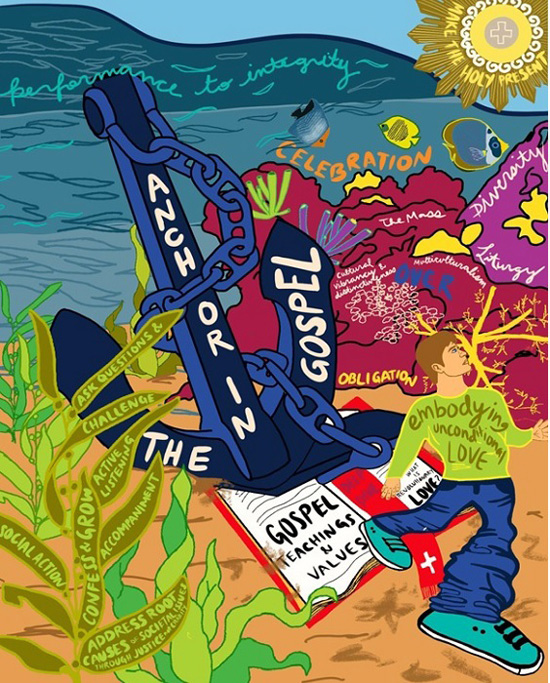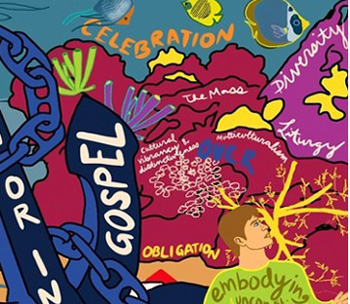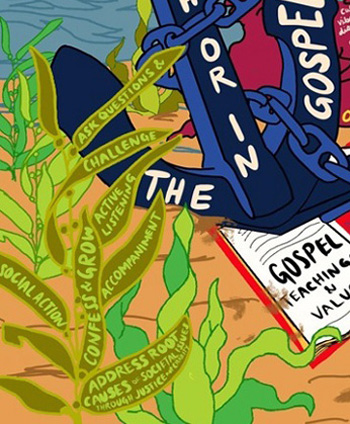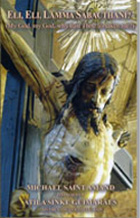Consequences of Vatican II
 |
 |
 |
 |
 |
 |
 |
The Synod’s Art – Part I
A Deep Dive into the Revolution
After the conclusion of the Second Vatican Council, Fr. Karl Rahner, one of its leading theologians, infamously stated that “what is most important in the Council is not the letter of the decrees it promulgated … its spirit, its more advanced tendencies, this is what is the most important.” (1)
These “advanced tendencies” imply the complete subversion of both the temporal and ecclesiastical orders, against which the Council’s official words might even be called conservative. Therefore, given the progression of the Revolution, might there be another, more radical “council” to express these aims directly?
I place “council” in marks because an actual council, which functions as an exercise of papal authority, now appears passé to progressivists. I theorize that the coming “Synod on Synodality” might be intended to represent the final blow to any vestige of Tradition in the Conciliar Church.
By the Pope’s own admission, the goal of the synod is to set aside the monarchical character of the Church, bringing greater power to the laity. Sadly, this even includes the “power” to reframe or delete doctrines. It is a Church of public opinion.
Under the guise of simply giving a voice to laypeople, official Vatican-run accounts on Facebook and Instagram have recently been promoting heretical ideas. In this series, I will analyze a recent collection of art pieces that were published by these accounts on September 25.
These images, which typify the democratization of the Church, were created by Becky McIntrye, an artist who provides art for the socialist Catholic Worker Movement. However, my aim is not to criticize McIntyre per se, but to question the Vatican’s decision to publish her work, thereby implicitly accepting it.

While the images are unnamed and seem to be in no particular order, I will begin with this one, which features a large anchor sitting on a bed of sand in the bottom of the ocean.
The first impression it creates is one of it ugliness, even despair. It is an unsettling portrait of modernity, calling attention simultaneously to the extravagance and emptiness that mark our world today. The sense of the sacred is entirely absent. The sun on the upper right corner, which boasts the phrase "Make the holy present" seems ironic. It is almost a mockery of holiness.
The eyes are quickly drawn to the large anchor in the center of the image. The anchor, of course, is a traditional symbol of the faith because it poetically displays the firm foundation Our Lord provides us. St. Ambrose wrote so many centuries ago that “as the anchor thrown from a ship prevents this from being borne about, but holds it securely, so does faith, strengthened by hope.”
Yet the anchor here, like the sun, is ironic, for there is nothing secure about the progressivist “Church” it represents. I am led to wonder why a young man is pictured underwater, rather than afloat in the Barque of Peter. He appears to have willingly cast himself down. A defiant gaze on his face, he walks forward in his modern clothes and disproportionately large tennis shoes, eager to reject the Church’s past and embrace something of his own making. His “unconditional love,” plastered on his t-shirt and his countenance, is really a hatred of Catholic militancy and intransigence.
The “gospel” offers a similar sentiment. With no mention of Christ, it embraces “revolutionary love.” In other words, the Church must evolve and love what she previously abhorred: sin and error. Though it is not immediately apparent, this false gospel also contains the disturbing phrase “deep dive.” A reference to the theme of being underwater, it, like the presence of the young man, also seems to convey a fall from grace.
 Next to the anchor is a coral reef that contains a confusing conglomeration of words, perhaps referring to the attributes of the progressivist synodal Church. The phrase “celebration over obligation” is highlighted in capital letters, indicating the way in which the rest of the words are meant to be read. The Mass, once a sacrifice, now becomes a community celebration.
Next to the anchor is a coral reef that contains a confusing conglomeration of words, perhaps referring to the attributes of the progressivist synodal Church. The phrase “celebration over obligation” is highlighted in capital letters, indicating the way in which the rest of the words are meant to be read. The Mass, once a sacrifice, now becomes a community celebration.
Other words on the coral reef refer to a similar (distorted) notion of community: “cultural vibrancy and distinctiveness,” “multiculturalism,” and “diversity.” Needless to say, the authentic diversity of cultures is good, but here the artist more likely refers to the embrace of globalism, tribalism, and non-Catholic societies.
 The image also includes seaweed with seven branches, The seven possibly mimicking the seven sacraments. The seven progressivist sacraments appear to be “confess and grow,” “ask questions,” “challenge," "active listening,” “accompaniment,” “social action,” and “address root causes of social issues through justice and charity.”
The image also includes seaweed with seven branches, The seven possibly mimicking the seven sacraments. The seven progressivist sacraments appear to be “confess and grow,” “ask questions,” “challenge," "active listening,” “accompaniment,” “social action,” and “address root causes of social issues through justice and charity.”
These phrases speak for themselves. In addition to a Church that deliberately mistrusts the established doctrines and ways of being, the new sacraments hearken back to the idea of “revolutionary love.” This new church follows a vague concept of social justice, which can essentially mean anything, depending on the whims of whoever is speaking. It inverts the core message of Christianity from being about worship of God to worship of man.
At the top of the photo, we can see the phrase, “performance to integrity.” This signifies the move away from the sacred ceremonies of the Church, which feel much too formal to progressivists. According to this mindset, pomp and solemnity is inherently false; it is the antithesis of sincerity and genuine devotion. Needless to say, this is untrue. In fact, it was these ceremonial aspects of Christianity that produced the heroic virtue of the Saints.
Continued

These “advanced tendencies” imply the complete subversion of both the temporal and ecclesiastical orders, against which the Council’s official words might even be called conservative. Therefore, given the progression of the Revolution, might there be another, more radical “council” to express these aims directly?
I place “council” in marks because an actual council, which functions as an exercise of papal authority, now appears passé to progressivists. I theorize that the coming “Synod on Synodality” might be intended to represent the final blow to any vestige of Tradition in the Conciliar Church.
By the Pope’s own admission, the goal of the synod is to set aside the monarchical character of the Church, bringing greater power to the laity. Sadly, this even includes the “power” to reframe or delete doctrines. It is a Church of public opinion.
Under the guise of simply giving a voice to laypeople, official Vatican-run accounts on Facebook and Instagram have recently been promoting heretical ideas. In this series, I will analyze a recent collection of art pieces that were published by these accounts on September 25.
These images, which typify the democratization of the Church, were created by Becky McIntrye, an artist who provides art for the socialist Catholic Worker Movement. However, my aim is not to criticize McIntyre per se, but to question the Vatican’s decision to publish her work, thereby implicitly accepting it.

While the images are unnamed and seem to be in no particular order, I will begin with this one, which features a large anchor sitting on a bed of sand in the bottom of the ocean.
The first impression it creates is one of it ugliness, even despair. It is an unsettling portrait of modernity, calling attention simultaneously to the extravagance and emptiness that mark our world today. The sense of the sacred is entirely absent. The sun on the upper right corner, which boasts the phrase "Make the holy present" seems ironic. It is almost a mockery of holiness.
The eyes are quickly drawn to the large anchor in the center of the image. The anchor, of course, is a traditional symbol of the faith because it poetically displays the firm foundation Our Lord provides us. St. Ambrose wrote so many centuries ago that “as the anchor thrown from a ship prevents this from being borne about, but holds it securely, so does faith, strengthened by hope.”
Yet the anchor here, like the sun, is ironic, for there is nothing secure about the progressivist “Church” it represents. I am led to wonder why a young man is pictured underwater, rather than afloat in the Barque of Peter. He appears to have willingly cast himself down. A defiant gaze on his face, he walks forward in his modern clothes and disproportionately large tennis shoes, eager to reject the Church’s past and embrace something of his own making. His “unconditional love,” plastered on his t-shirt and his countenance, is really a hatred of Catholic militancy and intransigence.
The “gospel” offers a similar sentiment. With no mention of Christ, it embraces “revolutionary love.” In other words, the Church must evolve and love what she previously abhorred: sin and error. Though it is not immediately apparent, this false gospel also contains the disturbing phrase “deep dive.” A reference to the theme of being underwater, it, like the presence of the young man, also seems to convey a fall from grace.

Other words on the coral reef refer to a similar (distorted) notion of community: “cultural vibrancy and distinctiveness,” “multiculturalism,” and “diversity.” Needless to say, the authentic diversity of cultures is good, but here the artist more likely refers to the embrace of globalism, tribalism, and non-Catholic societies.

These phrases speak for themselves. In addition to a Church that deliberately mistrusts the established doctrines and ways of being, the new sacraments hearken back to the idea of “revolutionary love.” This new church follows a vague concept of social justice, which can essentially mean anything, depending on the whims of whoever is speaking. It inverts the core message of Christianity from being about worship of God to worship of man.
At the top of the photo, we can see the phrase, “performance to integrity.” This signifies the move away from the sacred ceremonies of the Church, which feel much too formal to progressivists. According to this mindset, pomp and solemnity is inherently false; it is the antithesis of sincerity and genuine devotion. Needless to say, this is untrue. In fact, it was these ceremonial aspects of Christianity that produced the heroic virtue of the Saints.
Continued
- Statement by Karl Rahner in Anton Holzer, Vatikanum II – Reformkonzil oder Konstituante einer neuen Kirche, Basel: Saka, 1967, p. 134.

Posted October 24, 2022
______________________
______________________
 Volume I |
 Volume II |
 Volume III |
 Volume IV |
 Volume V |
 Volume VI |
 Volume VII |
 Volume VIII |
 Volume IX |
 Volume X |
 Volume XI |
 Special Edition |


